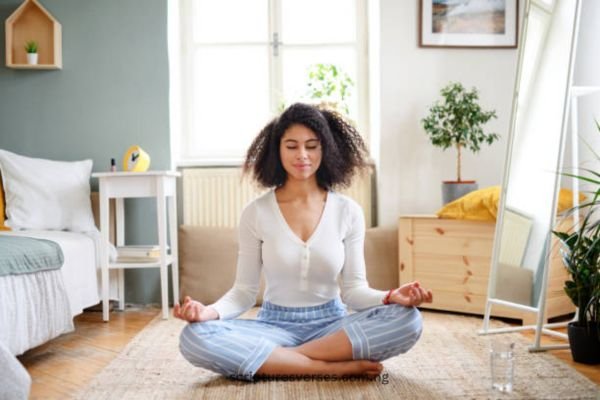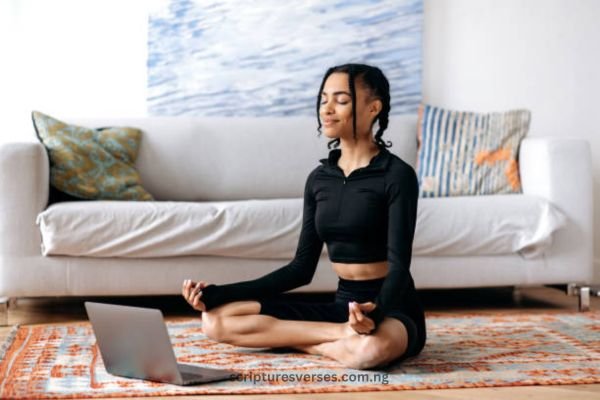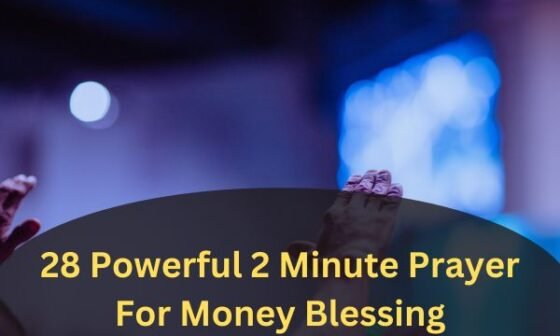Anxiety is a multifaceted emotional reaction that frequently includes unease, fear, or concern. Knowing where it came from is crucial to managing it well. Genetics, stressful environments, traumatic events, or even chemical imbalances in the brain can all contribute to anxiety. As meditation directly affects the neural system, it is one of the best strategies for reducing anxiety. The body switches into “fight-or-flight” mode when you’re nervous. By relaxing the mind and stimulating the parasympathetic nervous system, meditation aids in the body’s restoration to equilibrium.
Meditation For Anxiety

It has long been known that meditation is an effective method for lowering anxiety and relaxing the mind. When prayer is added to meditation, it incorporates God into the practice and combines mental discipline with mindfulness, breath control, or images. In addition to reducing anxiety, this integration fortifies your spiritual path and restores equilibrium to your body, mind, and soul.
1. Mindfulness Meditation
One of the most well-liked and approachable types of meditation is mindfulness meditation. This technique allows thoughts and sensations to come and go as they naturally arise while focusing on the present moment without passing judgment. By bringing attention to your breath, body sensations, or environment, you learn to observe your thoughts without getting caught up in them.
This technique becomes active surrender when combined with prayer, moving it from passive observation. You might pray for divine intervention when you recognize your worried thoughts and ask God to give you clarity and serenity. Prayer enables people to communicate their concerns, ask for divine intervention, and welcome peace into their hearts, whereas meditation concentrates on mind-calming techniques.
“Heavenly Father, I come before You with my anxious heart. You know the fears that overwhelm me, but I trust in Your promise to never leave me. Fill me with Your peace, calm my spirit, and remind me that I am never alone. Amen.”
2. Body Scan Meditation
Body scan meditation provides awareness to each region of your body, helping you release tension and discover where worry may be hidden. You can ask God to heal and ease the physical and mental tension in those areas by include prayer.
Heavenly Father, Jehovah Rapha, the God who heals, I invite You into my body and soul right now. As I scan each part of my being, I ask You to release the tension, stress, and anxiety that weigh me down. Relax my muscles, calm my racing heart, and soothe my troubled mind. May Your healing presence fill every part of me, bringing peace where there was unrest. Thank You for being my refuge and strength. In Jesus’ name, Amen.”
While body scan meditation focuses on bodily awareness, prayer releases tension in those regions by bringing heavenly healing. This combination treats both physical pain and mental distress, providing holistic recovery.
3. Guided Visualization
With the use of guided visualization, you may push away from nervous thoughts by picturing serene, comforting situations, and with prayers you invite God to be part of the serene mental imagery, enhancing the sense of divine comfort and protection.
During guided visualization, the mind establishes a secure and tranquil environment. Through the use of prayer, the scenario is elevated from a work of fiction to a spiritual haven where you may really feel the calm of God.
4. Loving-Kindness Meditation (Metta) with Prayer
Loving-kindness meditation (Metta) cultivates compassion, beginning with yourself and extending to others. This meditation can be transformed into an act of divine intercession by integrating prayer, in which you ask God to guide, protect, and bless everyone you focus on, including yourself.
“Merciful Father, the God of love, I lift myself and others before You in prayer. I ask for Your kindness and mercy to fill my heart, that I may be compassionate towards myself in moments of anxiety. May Your love flow through me, allowing me to bless others, especially those who are also struggling. Pour out Your peace upon me, and grant that I may share it with those around me. May all beings be happy, healthy, and at peace, in the power of Your love. Amen.”
Kindness and love Concentration on external compassion replaces internalized worry during meditation. You may align with God’s love and strengthen the feeling of purpose and connection that might dispel anxiety by praying for yourself and other people.
5. Breathing Meditation (Pranayama)
Breathing meditation focuses on controlling and slowing your breath, which can immediately calm anxiety. When you pair breath control with prayer, each breath becomes a sacred act of communion with God, filling you with His presence and peace.
Breathing meditation gives instant physical comfort by soothing the nervous system, while prayer converts each breath into a moment of spiritual connection. This dual strategy reduces anxiety by emphasizing both inner peace and bodily tranquility.
6. Walking Meditation
Moving while meditating is called walking meditation. Including prayer in this practice makes every step a prayerful act, asking God to walk with you and lead you through your moments of anxiety. Walking meditation helps anchor you in the present, and when paired with prayer, it invites God to walk alongside you, converting the journey into a time of communion and trust in His guidance.
7. Zen Meditation (Zazen) with Prayer
Zen meditation places a strong emphasis on sitting motionless and quieting the mind. This stillness becomes a place for hearing God’s voice and experiencing His peace when prayer is included. When prayer is added to the mental space created by Zen meditation, it becomes a place for divine communication. This develops the practice, enabling God’s peace to fill the quiet.
The Role Of Prayer In Meditation For Anxiety
1. Combining Prayer and Meditation: A Pathway to Inner Peace
Prayer and meditation are both paths to inner peace, but when combined, they offer even greater tranquility. This section explores practical ways to integrate prayer into meditation, such as starting or ending meditation sessions with a heartfelt prayer, or repeating short prayers as a meditative mantra.
“God of Peace, I quiet my thoughts and center myself in Your love. As I breathe in Your grace and breathe out my worries, help me to trust You fully with all that burdens my heart. Let Your peace guard my mind and soul. Amen.”
2. How Prayer Enhances Meditation for Anxiety Relief
Combining prayer with meditation creates a holistic practice for dealing with anxiety. While meditation calms the mind through focus and breath control, prayer deepens that peace by aligning one’s spirit with God’s presence.
“Lord, as I meditate and focus on my breath, I invite You into this moment of stillness. Clear my mind of anxious thoughts and replace them with Your presence. Help me to find rest in You. Amen.”
3. The Role of Faith and Trust in God in Overcoming Anxiety
Anxiety often stems from fear and uncertainty, and prayer helps by nurturing faith and trust in God’s plan. This section will focus on how faith can counteract anxiety, emphasizing the belief that God is in control even when life feels overwhelming.
“Father, I choose to trust You even when my heart is troubled. I know that You are greater than my fears, and I place my anxiety in Your hands. Strengthen my faith and remind me that You are with me every step of the way. Amen.”
4. Scripture-Based Prayers for Calm and Tranquility
The Bible is filled with verses that offer peace and comfort during anxious times. This section will highlight key scriptures, such as Philippians 4:6-7 and Psalm 46:10, and demonstrate how to incorporate these verses into personal prayers.
“Lord, Your Word says, ‘Be still and know that I am God.’ In the stillness of this moment, I release my anxieties to You. Let Your peace, which surpasses all understanding, guard my heart and mind in Christ Jesus. Amen.”
5. Surrendering Anxiety to God
Holding onto control and trying to fix every situation can increase anxiety. Surrendering anxiety to God is a key element of prayer, as it acknowledges that we can’t handle everything on our own.
“Father, I lay my worries at Your feet. I can’t carry this anxiety anymore, and I need You to take it from me. I surrender control, knowing that Your plan is perfect and Your care for me is endless. Amen.”
6. Prayers for Strength and Courage in Moments of Anxiety
Anxiety often leaves people feeling weak or incapable. Prayers for strength and courage help build resilience, reminding individuals that God is their source of power in difficult moments.
“Lord, in my weakness, You are strong. Fill me with Your courage to face my fears and strength to rise above my anxiety. Remind me that with You, I can overcome anything that comes my way. Amen.”
7. Prayers of Affirmation: Speaking God’s Promises Over Your Anxiety
Affirming God’s promises through prayer strengthens faith and shifts focus away from anxiety.
“Lord, You have promised that You will never leave me nor forsake me. I declare that I am safe in Your hands, and no fear can overwhelm me when I trust in You. Your love drives out all fear, and I claim that peace over my life. Amen.”
How to Create a Prayer Routine During Meditation for Anxiety
Developing a prayer practice while meditation may improve your mental and emotional health tremendously, particularly if you are experiencing anxiety. This practice makes a specific area where you may commune with God, declutter, and concentrate on the here and now.
1. Set a Specific Time and Space
Creating a designated time and space for your prayer and meditation practice is vital for consistency. Select an uninterrupted period of day to concentrate; early in the morning or right before bedtime are usually good choices.Find a quiet space in your home where you can sit comfortably, free from interruptions. This space should feel peaceful and inviting, perhaps decorated with calming elements such as candles, soft lighting, or inspirational quotes.
2. Choose Your Posture
Your physical posture can impact your meditation and prayer experience. Choose a position that is comfortable and helps you to de-stress, whether it is lying down, sitting cross-legged on the floor, or sitting in a chair with your feet flat on the floor.Ensure that your back is straight, as this helps promote alertness and focus. Consider using cushions or blankets for added comfort.
3. Begin with Breath Awareness

Focus on your breathing at the beginning of your routine. Shut your eyes and inhale deeply through your nose and gently exhale through your lips for a few deep breaths. This practice helps center your mind and body, allowing you to transition into a meditative state. Pay attention to the rhythm of your breath, letting each inhale fill you with calm and each exhale release tension and anxiety.
4. Incorporate Scripture or Affirmations
Incorporating scripture or affirmations into your prayer routine can deepen your meditation experience. Choose verses that resonate with your current feelings of anxiety or that speak to God’s peace and comfort. For example, you might choose Philippians 4:6-7: “Do not be anxious about anything, but in every situation, by prayer and petition, with thanksgiving, present your requests to God.” Repeat these scriptures silently or aloud, allowing them to sink deep into your heart.
5. Engage in Prayer
Once you feel centered, begin your prayer. Start by addressing God using a name that feels personal to you, such as Father, Lord, or Savior. Express your worry in an honest and transparent manner. Express your anxieties, worries, and any burdens that weigh on your heart. Give God detailed details of your struggles and allow Him inside your feelings and thoughts.
6. Listen and Reflect
After expressing your concerns, take a moment to listen. This part of the routine is essential as it encourages a two-way conversation with God. Stay in a quiet state, allowing thoughts and impressions to flow without judgment. Be open to the possibility of receiving insight, comfort, or direction during this time. You might feel a sense of peace or clarity about your situation.
7. Close with Gratitude
End your meditation and prayer session with gratitude. Thank God for His presence, for listening to your prayers, and for the peace you’ve experienced during your time together. Acknowledge the strength you gain from this routine and the comfort of knowing that you are not alone in your struggles.
8. Practice Consistency
Creating a routine requires practice and consistency. Aim to set aside time for your prayer and meditation daily or several times a week. The more you engage in this practice, the more natural it will feel, and the more profound the benefits will become. Over time, you may find that your anxiety lessens, and your connection with God deepens.
Guided Meditation For Anxiety
This guided meditation is intended to assist you in finding serenity and calming your racing thoughts via connecting to God and conscious awareness. You will let go of your problems, bring God’s presence into your anxious moment, and concentrate on your breathing throughout this meditation.
Step 1: Centering and Breathing
After finding a comfortable posture, close your eyes softly and inhale deeply through your nose until your lungs are full. Hold the breath for a moment, and then slowly exhale through your mouth, releasing any tension in your body.
Continue to breathe deeply and evenly, allowing your breath to be your anchor to the present moment. With each inhale, breathe in peace and calm. With each exhale, breathe out tension, stress, and worry.
Take note of the rise and fall of your respiration. Observe the sensations of the air entering your body and leaving it out. Each breath gets you closer to serenity.
Step 2: Letting Go of Anxious Thoughts
Thoughts may arise while you breathe. These thoughts may be worries, fears, or anxieties. Allow them to come without judgment, but imagine that they are clouds drifting through the sky of your mind.
With each breath, gently let go of these anxious thoughts. Watch them pass by, but do not hold on to them. They are temporary, just like the clouds, and they will float away in time.
As you breathe out, say to yourself: “I release my anxieties. I trust in God’s peace.”
Step 3: Inviting God’s Presence
Now pause to allow God to join you in your meditation. Visualize God sitting next to you, resting His consoling hand on your shoulder. Feel His presence surrounding you like a warm, protective light.
Speak to Him in your heart, and say:
“Lord, You are my refuge and my strength. I invite Your peace into my heart. As I sit here in stillness, I know that You are with me. Help me release all my fears into Your loving hands. Fill me with Your calm, and remind me that You are greater than any storm. Amen.”
Feel the peace of God wash over you, filling your heart with a deep sense of calm and reassurance. Allow yourself to rest in this moment, knowing that He is here, holding your worries for you.
Step 4: Visualizing Peace
Imagine yourself in a peaceful area right now. It may be a peaceful mountain top with a view of a tranquil valley, a forest full of birdsong, or a beach with soft waves crashing into the sand. Imagine this location clearly in your thoughts.
As you visualize this peaceful place, imagine that God is with you there. Feel the warmth of His presence beside you. Let the serenity of this place fill your heart, washing away all anxiety.
Whenever anxious thoughts try to return, gently bring your mind back to this peaceful scene, knowing that God is there with you.
Step 5: Affirming God’s Protection
Take a few moments now to reflect on God’s promises. You are not alone. God is with you in your anxiety, offering comfort, strength, and peace.
Repeat these affirmations quietly to yourself:
“I am safe in God’s hands.”
“God’s peace is greater than my fears.”
“I trust God to calm my anxious heart.”
Each affirmation is a reminder that God’s presence is always with you, even in moments of anxiety.
Step 6: Closing and Returning
As you prepare to finish this meditation, take a few deep breaths. Slowly bring your awareness back to the present moment, knowing that the peace of God you experienced in this meditation is something you can carry with you throughout your day.
When you are ready, gently open your eyes. Feel the peace of God that remains with you, and remember that whenever anxiety returns, you can find comfort in His presence.
Closing Prayer:
“Loving Father, Prince of Peace, I thank You for this moment of calm. As I return to my day, may Your peace remain with me. Help me to trust in You, knowing that You are greater than my fears. Guard my heart and mind with Your presence, and lead me in Your ways. In Your holy name, Amen.”
The meditative benefits of several techniques are enhanced when prayer is included. Prayer calls on heavenly help, laying a spiritual basis for tranquility, while meditation trains the mind and body. This combination works especially well to soothe anxious minds because it takes care of anxiety on all levels—mental, bodily, and spiritual—by taking solace and strength from God.







